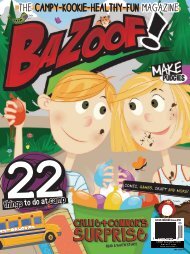B! Maggle #001 Canada
B! Maggle is a series of health and history magazines targeting ages 7-12. Set in an alien school, in the space city of BAZOOF!, readers engage themselves in articles, artwork and stories created by youth across Canada. B! Maggle educates youth on making healthy lifestyle choices, personal care, safety, eco education, important Canadian history and more!
B! Maggle is a series of health and history magazines targeting ages 7-12. Set in an alien school, in the space city of BAZOOF!, readers engage themselves in articles, artwork and stories created by youth across Canada. B! Maggle educates youth on making healthy lifestyle choices, personal care, safety, eco education, important Canadian history and more!
You also want an ePaper? Increase the reach of your titles
YUMPU automatically turns print PDFs into web optimized ePapers that Google loves.
THE<br />
TRUE<br />
TALE<br />
OF THE<br />
McINTOSH<br />
APPLE!<br />
Isn’t it true that sometimes the best things in life happen by accident? The McIntosh<br />
story is an unbelievable tale of how this apple came into existence completely<br />
by chance and went on to become one of the most popular apples in the world!<br />
Way Back in the Days of 1811 The first McIntosh apple tree<br />
is believed to have sprung up in southeastern Ontario. It was<br />
one of a few scattered apple trees that were discovered<br />
by John McIntosh when he was clearing land to build<br />
a house. When transplanting them, only one survived.<br />
Apple Seeds and Apple Trees One thing you need to<br />
understand before we go any further with this tale is that if you<br />
plant apple seeds in the ground to grow a new tree, that<br />
tree won’t grow the same type of apples. It just doesn’t<br />
work that way! It will grow something slightly different.<br />
A Toss in the Right Direction Most likely these trees<br />
discovered by John had sprouted from an apple core that had<br />
been thrown out on the ground. From its branches came the<br />
most flavorful, shiny, red apples anyone in the district had<br />
ever seen or tasted.<br />
A New Apple is Born! John was happy to give seeds<br />
from these delicious apples to all the neighbours, but no<br />
one could grow the same type of apple! We know why! In 1835,<br />
a farmhand explained to the McIntosh’s son, Allan, that the only<br />
way to reproduce the exact fruit of the tree was by grafting a<br />
branch onto another root. Allan was soon grafting new trees for<br />
the orchard and began selling the saplings over eastern Ontario.<br />
And that is how the McIntosh apple got its start! b bazoof.com 7<br />
Apple Picking<br />
Apples are still picked by hand today. Pickers use baskets, which<br />
they empty into bins. A good worker can fill four bins in a day,<br />
each holding about 2,250 apples! That’s 9,000 apples!<br />
Boxes vs. Barrels<br />
Although apples had long been shipped in barrels, the market began to complain that<br />
they did not offer enough protection. So by the early 20th century, smaller wooden<br />
boxes became widely used instead of the barrels.







